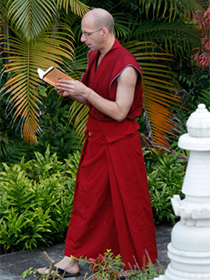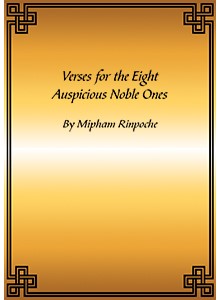- Home
- FPMT Homepage
Foundation for the Preservation of the Mahayana Tradition
The FPMT is an organization devoted to preserving and spreading Mahayana Buddhism worldwide by creating opportunities to listen, reflect, meditate, practice and actualize the unmistaken teachings of the Buddha and based on that experience spreading the Dharma to sentient beings. We provide integrated education through which people’s minds and hearts can be transformed into their highest potential for the benefit of others, inspired by an attitude of universal responsibility and service. We are committed to creating harmonious environments and helping all beings develop their full potential of infinite wisdom and compassion. Our organization is based on the Buddhist tradition of Lama Tsongkhapa of Tibet as taught to us by our founders Lama Thubten Yeshe and Lama Thubten Zopa Rinpoche.
- Willkommen
Die Stiftung zur Erhaltung der Mahayana Tradition (FPMT) ist eine Organisation, die sich weltweit für die Erhaltung und Verbreitung des Mahayana-Buddhismus einsetzt, indem sie Möglichkeiten schafft, den makellosen Lehren des Buddha zuzuhören, über sie zur reflektieren und zu meditieren und auf der Grundlage dieser Erfahrung das Dharma unter den Lebewesen zu verbreiten.
Wir bieten integrierte Schulungswege an, durch denen der Geist und das Herz der Menschen in ihr höchstes Potential verwandelt werden zum Wohl der anderen – inspiriert durch eine Haltung der universellen Verantwortung und dem Wunsch zu dienen. Wir haben uns verpflichtet, harmonische Umgebungen zu schaffen und allen Wesen zu helfen, ihr volles Potenzial unendlicher Weisheit und grenzenlosen Mitgefühls zu verwirklichen.
Unsere Organisation basiert auf der buddhistischen Tradition von Lama Tsongkhapa von Tibet, so wie sie uns von unseren Gründern Lama Thubten Yeshe und Lama Thubten Zopa Rinpoche gelehrt wird.
- Bienvenidos
La Fundación para la preservación de la tradición Mahayana (FPMT) es una organización que se dedica a preservar y difundir el budismo Mahayana en todo el mundo, creando oportunidades para escuchar, reflexionar, meditar, practicar y actualizar las enseñanzas inconfundibles de Buda y en base a esa experiencia difundir el Dharma a los seres.
Proporcionamos una educación integrada a través de la cual las mentes y los corazones de las personas se pueden transformar en su mayor potencial para el beneficio de los demás, inspirados por una actitud de responsabilidad y servicio universales. Estamos comprometidos a crear ambientes armoniosos y ayudar a todos los seres a desarrollar todo su potencial de infinita sabiduría y compasión.
Nuestra organización se basa en la tradición budista de Lama Tsongkhapa del Tíbet como nos lo enseñaron nuestros fundadores Lama Thubten Yeshe y Lama Zopa Rinpoche.
A continuación puede ver una lista de los centros y sus páginas web en su lengua preferida.
- Bienvenue
L’organisation de la FPMT a pour vocation la préservation et la diffusion du bouddhisme du mahayana dans le monde entier. Elle offre l’opportunité d’écouter, de réfléchir, de méditer, de pratiquer et de réaliser les enseignements excellents du Bouddha, pour ensuite transmettre le Dharma à tous les êtres. Nous proposons une formation intégrée grâce à laquelle le cœur et l’esprit de chacun peuvent accomplir leur potentiel le plus élevé pour le bien d’autrui, inspirés par le sens du service et une responsabilité universelle. Nous nous engageons à créer un environnement harmonieux et à aider tous les êtres à épanouir leur potentiel illimité de compassion et de sagesse. Notre organisation s’appuie sur la tradition guéloukpa de Lama Tsongkhapa du Tibet, telle qu’elle a été enseignée par nos fondateurs Lama Thoubtèn Yéshé et Lama Zopa Rinpoché.
Visitez le site de notre Editions Mahayana pour les traductions, conseils et nouvelles du Bureau international en français.
Voici une liste de centres et de leurs sites dans votre langue préférée
- Benvenuto
L’FPMT è un organizzazione il cui scopo è preservare e diffondere il Buddhismo Mahayana nel mondo, creando occasioni di ascolto, riflessione, meditazione e pratica dei perfetti insegnamenti del Buddha, al fine di attualizzare e diffondere il Dharma fra tutti gli esseri senzienti.
Offriamo un’educazione integrata, che può trasformare la mente e i cuori delle persone nel loro massimo potenziale, per il beneficio di tutti gli esseri, ispirati da un’attitudine di responsabilità universale e di servizio.
Il nostro obiettivo è quello di creare contesti armoniosi e aiutare tutti gli esseri a sviluppare in modo completo le proprie potenzialità di infinita saggezza e compassione.
La nostra organizzazione si basa sulla tradizione buddhista di Lama Tsongkhapa del Tibet, così come ci è stata insegnata dai nostri fondatori Lama Thubten Yeshe e Lama Zopa Rinpoche.
Di seguito potete trovare un elenco dei centri e dei loro siti nella lingua da voi prescelta.
- 欢迎 / 歡迎
简体中文
“护持大乘法脉基金会”( 英文简称:FPMT。全名:Foundation for the Preservation of the Mahayana Tradition) 是一个致力于护持和弘扬大乘佛法的国际佛教组织。我们提供听闻,思维,禅修,修行和实证佛陀无误教法的机会,以便让一切众生都能够享受佛法的指引和滋润。
我们全力创造和谐融洽的环境, 为人们提供解行并重的完整佛法教育,以便启发内在的环宇悲心及责任心,并开发内心所蕴藏的巨大潜能 — 无限的智慧与悲心 — 以便利益和服务一切有情。
FPMT的创办人是图腾耶喜喇嘛和喇嘛梭巴仁波切。我们所修习的是由两位上师所教导的,西藏喀巴大师的佛法传承。
繁體中文
護持大乘法脈基金會”( 英文簡稱:FPMT。全名:Found
ation for the Preservation of the Mahayana Tradition ) 是一個致力於護持和弘揚大乘佛法的國際佛教組織。我們提供聽聞, 思維,禪修,修行和實證佛陀無誤教法的機會,以便讓一切眾生都能 夠享受佛法的指引和滋潤。 我們全力創造和諧融洽的環境,
為人們提供解行並重的完整佛法教育,以便啟發內在的環宇悲心及責 任心,並開發內心所蘊藏的巨大潛能 — 無限的智慧與悲心 – – 以便利益和服務一切有情。 FPMT的創辦人是圖騰耶喜喇嘛和喇嘛梭巴仁波切。
我們所修習的是由兩位上師所教導的,西藏喀巴大師的佛法傳承。 察看道场信息:
- FPMT Homepage
- News/Media
-
- Study & Practice
-
-
- About FPMT Education Services
- Latest News
- Programs
- New to Buddhism?
- Buddhist Mind Science: Activating Your Potential
- Heart Advice for Death and Dying
- Discovering Buddhism
- Living in the Path
- Exploring Buddhism
- FPMT Basic Program
- FPMT Masters Program
- FPMT In-Depth Meditation Training
- Maitripa College
- Lotsawa Rinchen Zangpo Translator Program
- Universal Education for Compassion & Wisdom
- Online Learning Center
-
- Prayers & Practice Materials
- Overview of Prayers & Practices
- Full Catalogue of Prayers & Practice Materials
- Explore Popular Topics
- Benefiting Animals
- Chenrezig Resources
- Death & Dying Resources
- Lama Chopa (Guru Puja)
- Lama Zopa Rinpoche: Compendium of Precious Instructions
- Lama Zopa Rinpoche: Life Practice Advice
- Lama Zopa Rinpoche Practice Series
- Lamrim Resources
- Mantras
- Prayer Book Updates
- Purification Practices
- Sutras
- Thought Transformation (Lojong)
- Audio Materials
- Dharma Dates - Tibetan Calendar
- Translation Services
- Publishing Services
- Ways to Offer Support
- Prayers & Practice Materials
-
- Teachings and Advice
- Find Teachings and Advice
- Lama Zopa Rinpoche Advice Page
- Lama Zopa Rinpoche: Compendium of Precious Instructions
- Lama Zopa Rinpoche Video Teachings
- ༧སྐྱབས་རྗེ་བཟོད་པ་རིན་པོ་ཆེ་མཆོག་ནས་སྩལ་བའི་བཀའ་སློབ་བརྙན་འཕྲིན།
- Podcasts
- Lama Yeshe Wisdom Archive
- Buddhism FAQ
- Dharma for Young People
- Resources on Holy Objects
- Teachings and Advice
-
-
*If a menu item has a submenu clicking once will expand the menu clicking twice will open the page.
-
-
- Centers
-
- Teachers
-
- Projects
-
-
-
-
*If a menu item has a submenu clicking once will expand the menu clicking twice will open the page.
-
-
- FPMT
-
-
-
-
-
Anybody who dedicates their life to achieving lam rim realizations with the goal to liberate numberless beings from the oceans of samsaric suffering and to bring to enlightenment, this is what I regard as the most important thing in the world.
Lama Zopa Rinpoche
-
-
-
- Shop
-
-
-
The Foundation Store is FPMT’s online shop and features a vast selection of Buddhist study and practice materials written or recommended by our lineage gurus. These items include homestudy programs, prayers and practices in PDF or eBook format, materials for children, and other resources to support practitioners.
Items displayed in the shop are made available for Dharma practice and educational purposes, and never for the purpose of profiting from their sale. Please read FPMT Foundation Store Policy Regarding Dharma Items for more information.
-
-
Study & Practice News
13
Learn to Chant Lama Chöpa Tunes

Lama Zopa Rinpoche during a Lama Chopa tsog in the garden of the Kopan House at Sera Je Monastery, India, December 20, 2015.

The Lama Chopa Merit Field
FPMT Education Services would like to remind students of three videos available in which Lama Zopa Rinpoche chants the Lama Chöpa tunes in three ways: fast-paced, medium-paced, and slow-paced. These videos are an incredibly precious resource for FPMT students. Learning these tunes will help ensure that the lineage of this practice is preserved.
These videos can be found on this webpage. Also, you may download the video files (available in low and high resolution) onto your computer or device in order to access them while offline or in retreat.
The FPMT Foundation Store has many resources to enrich your practice of Lama Chöpa, including the Lama Chöpa Tunes and Audio Guide.
Through comprehensive study programs, practice materials, training seminars, and scholarships, FPMT Education nourishes the development of compassion, wisdom, kindness, and true happiness in individuals of all ages.
- Tagged: lama chopa, lama chopa tunes
30
Preparing for the 2017 Light of the Path Retreat
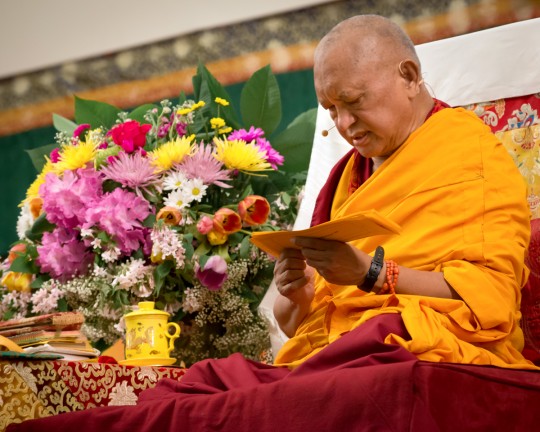
Lama Zopa Rinpoche teaching at Light of the Path Retreat, North Carolina, US, May 2014. Photo by Roy Harvey.
Registration is now open for the extended 2017 Light of the Path hosted by Kadampa Center in North Carolina, USA, and taking place August 20-September 17. We hope that many students will be able to attend in person or participate via livestream and archived video.
Lama Zopa Rinpoche has emphasized since the first Light of the Path retreat in 2009 that participants should review what he has previously taught so he can move forward at each new retreat with his commentary on Lama Atisha’s text, Lamp on the Path to Enlightenment.
Participants can prepare for Light of the Path 2017 by accessing the modules of the online program Living in the Path, specifically created to make Rinpoche’s extensive teachings available in bite-sized chunks for easier study and meditation. Alternatively, participants can watch the videos of the entire Light of the Path 2016 retreat, listen to the MP3 recordings, or read the unedited transcript.
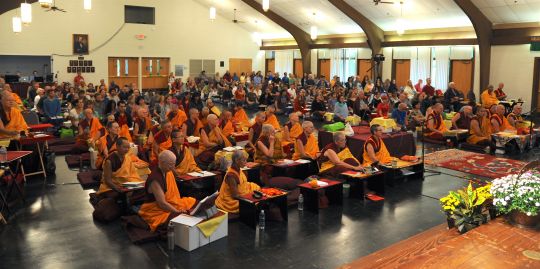
Participants of Lama Zopa Rinpoche’s 2016 Light of the Path retreat, Black Mountain, North Carolina, US, August 2016. Photo by Ven. Lobsang Sherab.
While it would be ideal to review all the modules of Living in the Path prior to Light of the Path 2017, participants can begin with some key modules such as “Guru Devotion: Guru is Buddha,” “Karma: Everything Comes from the Mind,” and “Emptiness: Bringing Emptiness to Life.” For a video introduction to these modules with a Western FPMT-registered teacher, see “Guru is Buddha: An Introduction to Guru Devotion” with Ven. Rene Feusi; “Karma: An Introduction” with Ven. Robina Courtin; and “Bringing Emptiness to Life: An Introduction” with Don Handrick.
In addition, participants are advised to already be familiar with two specific practices for generating bodhichitta that will be done during the retreat, both available to all. The first, The Method to Transform a Suffering Life into Happiness (Including Enlightenment), is a practice combining a short lamrim text, a blessing of the speech, and a few daily mantras, and was compiled by Lama Zopa Rinpoche for developing a bodhichitta motivation at the beginning of the day. It will be done either individually or as a group during the retreat. This practice is available as a booklet from the Foundation Store and can be found together with Rinpoche’s commentary as a module of Living in the Path. The second, Cultivating Mindfulness of Bodhichitta in Daily Activities, is a set of bodhichitta mindfulness practices compiled by Rinpoche for transforming our ordinary daily activities, such as washing, dressing, and so forth, into Dharma practice. This practice booklet is also available from the Foundation Store and can be found together with Rinpoche’s commentary as a module of Living in the Path.
We hope that you enjoy engaging with these most precious teachings and advice from Lama Zopa Rinpoche.
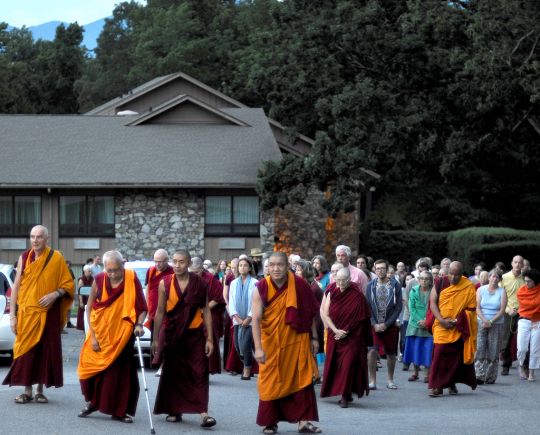
Lama Zopa Rinpoche leading walking meditation at Light of the Path 2016, Black Mountain, North Carolina, US, August 2016. Photo by Ven. Lobsang Sherab.
Through comprehensive study programs, practice materials, training seminars, and scholarships, FPMT Education nourishes the development of compassion, wisdom, kindness, and true happiness in individuals of all ages.
23
Resources for Realizing the Lamrim
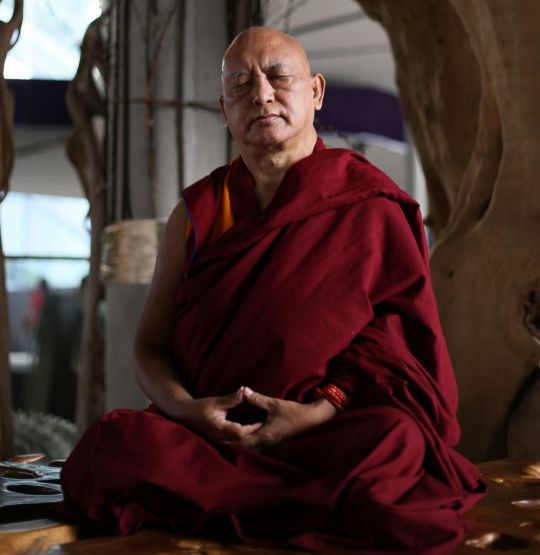
Lama Zopa Rinpoche in Singapore, 2013. Photo by Ven. Thubten Kunsang.
“What makes your life most meaningful is meditation on the lamrim, then to live your
life with bodhichitta motivation. This is the best.” – Lama Zopa Rinpoche
FPMT Education Services would like to remind you of several resources available to help you integrate the lamrim into daily life. “The most unbelievably important thing in our life is lamrim,” Lama Zopa Rinpoche teaches in the module “Advice for Realizing Lamrim,” which is part of Living in the Path, FPMT Education Services’ essential lamrim program. “The practice of the three principal aspects of the path is the most important thing. This is the most important, more important than a job, money, or anything else in our life. It is the most important thing.”
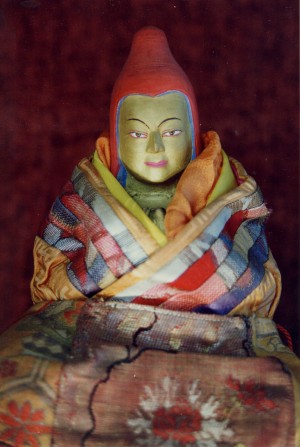
Statue of Lama Atisha (982-1054) at Kopan Monastery. Lama Atisha was author of Lamp on the Path to Enlightenment, the first text which established the lamrim genre.
Education Services has created a webpage devoted to lamrim with links to free resources and texts to assist you in your study and practice.
You can find “Lamrim Is the Most Important Thing,” which includes a short video clip of Rinpoche teaching, on FPMT’s Online Learning Center.
Lama Zopa Rinpoche gave advice suggesting that students follow a lamrim outline and meditate on each subject for two weeks or one month until all subjects have been completed. “The amount of time for meditation is up to the individual, but the general advice is to finish the lamrim in one year,” Rinpoche said. “To meditate like this each year—wow, wow, wow! That would be great.”
To help students follow this advice, we have created a schedule to help you plan daily lamrim meditation sessions over the course of a calendar year. It was created on the basis of the book The Essential Nectar by Geshe Rabten, which is available through the Foundation Store. The schedule is available as an Excel spreadsheet and PDF.
Through comprehensive study programs, practice materials, training seminars, and scholarships, FPMT Education nourishes the development of compassion, wisdom, kindness, and true happiness in individuals of all ages.
- Tagged: lamrim, lamrim chenmo
16
Verses for Success
The “Verses for the Eight Auspicious Noble Ones,” or “Tashi Gyepa” in Tibetan, is one of Mipham Rinpoche’s most well-known compositions and is recited daily by practitioners from a variety of traditions.
In these verses one pays homage to the Three Rare Sublime Ones (the Three Jewels), eight sugatas, the eight great bodhisattvas, the eight offering goddesses, and the eight worldly guardians. The text also describes the hand implements or offerings held by each of the eight bodhisattvas, goddesses, and guardians.
Lama Zopa Rinpoche has recommended reciting this prayer every morning for “the success of the center and your own success, the success of FPMT, and the holy wishes of His Holiness the Dalai Lama.”
All are welcome to download these auspicious verses and incorporate them into your morning prayer regimen.
Through comprehensive study programs, practice materials, training seminars, and scholarships, FPMT Education nourishes the development of compassion, wisdom, kindness, and true happiness in individuals of all ages.
9
Dharma Resources Available to You
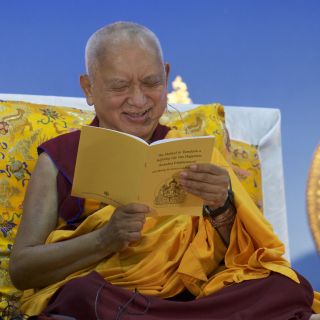
Lama Zopa Rinpoche reading from The Method to Transform a Suffering Life into Happiness, April, 2016. Photo by Bill Kane.
In this year’s annual review, Lama Zopa Rinpoche mentioned two practices that he’s asking students to focus on: The Method to Transform a Suffering Life into Happiness (Including Enlightenment) and How to Make Life Most Beneficial for Sentient Beings, Even with Your Speech. We wanted to remind students that these practices are available for free download.
Additionally, there are many prayers and practices, mantras, sutras, death and dying materials, and other resources available to support your Dharma study and practice.
The Foundation Store is the online store of FPMT International Office. The store helps students access prayers and practice materials; meditation supplies such as malas, incense, ritual items, thangkas, and statues; and FPMT homestudy and online education programs. There are more than 700 downloadable products available including PDFs, ebooks, MP3s, and online courses.
We hope that you will take full advantage of all that is available to you and we wish you every success in your Dharma studies!
Through comprehensive study programs, practice materials, training seminars, and scholarships, FPMT Education nourishes the development of compassion, wisdom, kindness, and true happiness in individuals of all ages.
- Tagged: how to make life most beneficial, resources, the method to transform a suffering life into happiness
2
Purification Practice during the Fifteen Days of Miracles
We are currently amid a group of Buddha Multiplying Days and wanted to bring your attention to some resources available for students interested in purification practices during this time.
Days one through fifteen of the first month of the Tibetan calendar mark a period when Lord Buddha performed many miracles, beginning with Losar (the Tibetan New Year) on the first day and culminating on the fifteenth day, Chotrul Duchen (the Day of Miracles). On Buddha Multiplying Days, karmic results are multiplied by one hundred million, as cited by Lama Zopa Rinpoche from the vinaya text Treasure of Quotations and Logic.
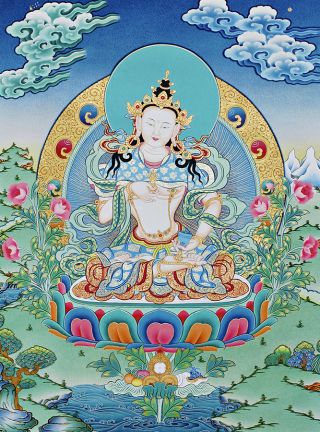
Vajrasattva. Artist unknown.
Losar took place this year on Monday, February 27 and the Fifteen Days of Miracles continues through Chotrul Duchen on Sunday, March 12.
Lama Zopa Rinpoche has taught extensively on benefits of engaging in Vajrasattva practice for purification.
“Vajrasattva practice is so important generally, and especially nowadays in the world, when there is not only global warming, but many other problems,” Rinpoche explained in The Benefits of Vajrasattva Practice. “There are so many other dangers—of war and sicknesses, cancer, and so many people whom you know are dying. There are so many sicknesses and other conditions for dying.
“This Vajrasattva practice and other purification practices are the ultimate answer, so everything in the world—what you see, every situation—tells you to practice Vajrasattva. To purify and do Vajrasattva practice is the ultimate answer, to stop the cause to be reborn in the lower realms and the immediate [result] is to have a higher rebirth, to make preparation for death and then to meet the Dharma, to meet the virtuous friend who reveals the path to enlightenment. Then to achieve ultimate happiness, to be free from samsara and to achieve enlightenment for the numberless sentient beings and to free them from the oceans of samsaric sufferings and bring them to full enlightenment.”
The FPMT Foundation Store offers many resources to support students in their Vajrasattva practice. A short meditation with the four opponent powers is available as a downloadable PDF.
Through comprehensive study programs, practice materials, training seminars, and scholarships, FPMT Education nourishes the development of compassion, wisdom, kindness, and true happiness in individuals of all ages.
- Tagged: purification practice, vajrasattva
- 0
23
Advice for Practice on Lunar and Solar Eclipses

Thirty-five Confessional Buddhas thangka.
Lunar and solar eclipses are auspicious days for practice and provide opportunities for accumulating increased merit. Lama Zopa Rinpoche advises that the merit generated on lunar eclipses is multiplied by 700,000 and on solar eclipses is multiplied by 100 million.
On these multiplying days, any beneficial practices can be done. In particular, Rinpoche recommends:
- Recitation of the names of the Thirty-five Confession Buddhas
- Vajrasattva mantras
Any other meritorious activities advised by Lama Zopa Rinpoche are also good to do on these days, such as recitations of the Vajra Cutter Sutra, Sutra of Golden Light, and Sanghata Sutra, with extensive dedications. These texts are available on our sutras page.
This Sunday, February 26, is a solar eclipse and all are invited to participate in generating 100 million times the merit than what would be accumulated on a non-multiplying day.
You can read more about practices specifically recommended by Rinpoche for this and other Buddha Multiplying Days and check the Liberation Prison Project calendar for information on auspicious days for practice.
Through comprehensive study programs, practice materials, training seminars, and scholarships, FPMT Education nourishes the development of compassion, wisdom, kindness, and true happiness in individuals of all ages.
- Tagged: buddha multiplying days, eclipse, multiplying day
- 0
16
‘The Seven-Limb Prayer,’ A Living in the Path Module

Lama Zopa Rinpoche teaching at Light of the Path Retreat, North Carolina, US, May 2014. Photo by Roy Harvey.
“The Seven-Limb Prayer” is found in, and is the basis of, many prayers and practice texts, including “The King of Prayers” and Lama Chöpa. This powerful method was taught by the Buddha as a means to accumulate merit and purify negativities, whereby we create the cause to experience every happiness up to enlightenment.
In “The Seven-Limb Prayer,” a module of the Living in the Path program, Lama Zopa Rinpoche teaches the benefits of each limb (“prostration,” “offering,” “confession,” “rejoicing,” “requesting to remain,” “requesting to turn the wheel of Dharma,” and “dedication”) and how to practice them in the most effective way.
In this short video Ven. Chantal Tenzin Dekyi explains the meaning of “The Seven-Limb Prayer.”
Watch “The Seven-Limb Prayer – An Introduction” on YouTube:
www.youtube.com/watch?v=4PBDPaIR2E0
All of the modules of Living in the Path program are available on the FPMT Online Center. This program is ideal for anyone who wishes to deepen their personal practice and develop the realizations of the path to enlightenment by relying on Lama Zopa Rinpoche’s heart advice and teachings. As the teachings often assume familiarity with the lamrim, participants are recommended to have previously received teachings in the Tibetan Buddhist tradition.
Ven. Chantal Tenzin Dekyi (Chantal Carrerot) ordained in 1986. She studied extensively with Khensur Jampa Tegchok at Nalanda Monastery in France and at Sera Je Monastery in India. She has offered service in a variety of FPMT centers and has also taught in various countries. Since 2009 she has been resident teacher at Institut Vajra Yogini. She translates Buddhist philosophy texts into French and is currently the director of the International Mahayana Institute (IMI). Ven. Chantal is an FPMT registered teacher.
Living in the Path is an FPMT program taught exclusively by Lama Zopa Rinpoche, spiritual director of the FPMT. Plans are underway to also draw from the teachings of Lama Yeshe, FPMT’s founder, to offer a program that preserves the entire FPMT lineage.
- Tagged: living in the path, seven limb prayer
- 0
9
Prayers and Practices for the Time of Death
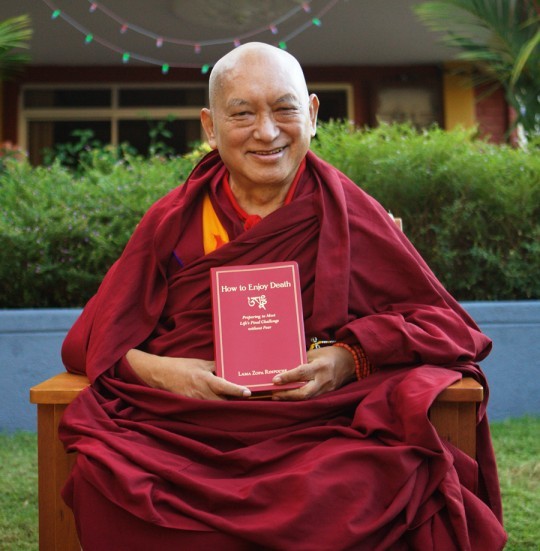
Lama Zopa Rinpoche with ‘How to Enjoy Death,’ Osel Labrang, Sera Monastery, India, December 2015.
Lama Zopa Rinpoche has given extensive advice and instruction for caring for ourselves and others during death and dying. FPMT Education Services would like to remind students of all the materials available to them for this critical time of transition.
Immediate Help
While Rinpoche’s advice on the subject has been vast, Medicine Buddha pujas and “Eight Prayers to Benefit the Dead” are the most recommended practices to do, should you need help immediately.
How to Enjoy Death
How to Enjoy Death: Preparing to Meet Life’s Final Challenge Without Fear brings together all the extensive commentary from Lama Zopa Rinpoche as well as a number of essential prayers, practices, and other materials that Lama Zopa Rinpoche has compiled over the years.
“We Buddhists all know about death and impermanence, but when death comes into our lives we often panic and don’t know what to do to help,” said Ven. Robina Courtin, the editor of How to Enjoy Death. “Rinpoche lays out all the instructions so clearly, one step at a time, for how to help our loved ones: what to do in the months and weeks before death, what to do in the hours before death, at the time the breath stops, and in the three days as well as the forty-nine days after death, including transforming our loved one’s ashes into a holy object.”
The condensed book of Rinpoche’s advice, Heart Practices for Death and Dying, contains the essential practices to do at the time of death.
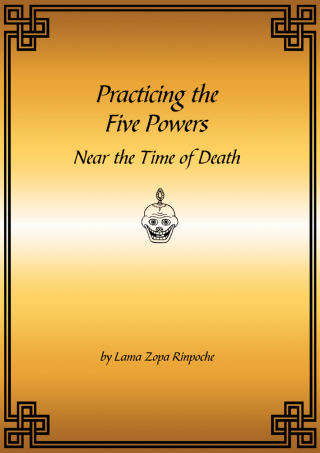
The Five Powers
Practicing the Five Powers Near the Time of Death by Lama Zopa Rinpoche contains advice and commentary to help ensure a peaceful death and positive rebirth. Although this book was intended for use by those facing imminent death, it is a deeply profound teaching on how to live life for anyone who wishes to make their life and eventual death most meaningful.
Rinpoche explains, “When you practice the five powers, every single thing you do is only for numberless sentient beings and therefore, everything you do only becomes the cause for achieving the peerless happiness of full enlightenment. This is the greatest profit that can be achieved with this life and so this practice is the most beneficial one for achieving peerless happiness. It means that every single action you do, whether it is meditation and prayers or doing your job, becomes the cause of happiness for all sentient beings. This means that you will have the best, happiest life now and also the best, happiest life in the future—like the sun shining in this world and eliminating all darkness.”

Heart Advice for Death and Dying
Heart Advice for Death and Dying is a collection of Lama Zopa Rinpoche’s essential advice and commentaries for the time of death. Teachings by Lama Zopa Rinpoche include, “The Nine-Point Meditation on Death,” “The Process of Dying,” “Preparing for Death,” “Practicing the Five Powers,” “Caring for the Dying and the Dead,” “Essential Activities at the Death Time,” and “Mantras to Benefit the Dying and Dead.” This collection also includes an MP3 CD of eleven hours of teachings on death by Ven. Sangye Khadro. In addition to the book and CD, this material is also available as a program for students more interested in structured study.
Available as:
- Hard copy book
- eBook
- FPMT Online Learning Center program
- Hard copy program for hosting centers
- PDF program for hosting centers
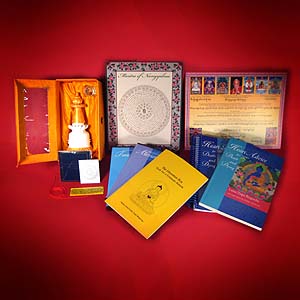
The Liberation Box contains many resources recommended by Lama Zopa Rinpoche to help at the time of death.
Liberation Box: Protection Tool for a Fortunate Rebirth
This invaluable collection of holy objects and essential blessed materials was put together on the advice of Lama Zopa Rinpoche.
Available as:
- Hard copy collection
- PDF digital edition, which does not include the stupa, phowa pill, and blessed cord
FPMT Education Services hopes that you will take full advantage of the resources available to you. Preparing for death is a wonderful service to offer oneself and our loved ones.
The FPMT Death and Dying Heart Practices and Advice webpage is kept up to date with all of Lama Zopa Rinpoche’s latest advice and materials concerning death and dying.
Through comprehensive study programs, practice materials, training seminars, and scholarships, FPMT Education nourishes the development of compassion, wisdom, kindness, and true happiness in individuals of all ages.
- Tagged: death, death and dying, dying
- 0
2
A Guide to Sanskrit Transliteration and Pronunciation
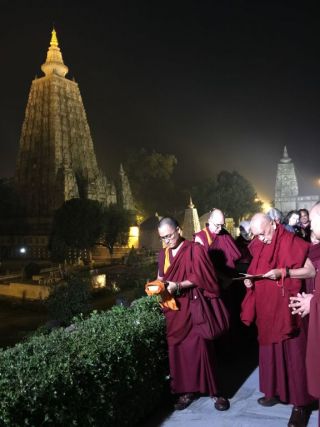
Lama Zopa Rinpoche with students at the Mahabodhi Stupa, Bodhgaya, India, February 2015.
FPMT Education Services is pleased to offer a new resource for FPMT students, A Guide to Sanskrit Transliteration and Pronunciation. We will soon begin releasing texts using transliterated Sanskrit and this document will help students with the reading and pronunciation of Sanskrit.
Lama Zopa Rinpoche places great importance on the correct pronunciation of Sanskrit mantras. For this reason, and following careful consideration, FPMT Education Services and FPMT Translation Services have decided to adopt the use of the standard international system for transliterating Sanskrit. This transliteration scheme, which entails the use of diacritical marks, will primarily be used in translations of Tibetan and Sanskrit texts.
In practice texts, transliteration will be restricted to cases where the Sanskrit is also transliterated in the Tibetan source text, which are usually mantras and seed syllables, and short phrases of homage. We will also be using in practice texts a modified form of transliteration, similar to that employed by Jeffrey Hopkins in many of his works, which will facilitate the pronunciation of some Sanskrit letters by non-specialists. For example, the mantra for blessing the offering of flowers, OṂ PUṢPE ĀḤ HŪṂ, will be written OṂ PUṢHPE ĀḤ HŪṂ, with an additional “h.”
In other types of texts, the standard internationally used system of transliteration will be used conservatively.
The use of transliteration is important for the exacting task of preserving and accurately transmitting the Dharma as contained within the vast bodies of Tibetan and Sanskrit Buddhist textual sources and is the only method through which we can accurately preserve and present a perfect spelling and pronunciation of the original Sanskrit.
It is important to note that many ways of pronouncing mantras exist and there is even variation in the pronunciation of mantras by different Tibetan lamas. For this reason, we encourage readers to follow the instructions of their own teachers.
While these changes may present some initial challenges, we hope that in the long term these changes will not only support the continued transmission of the Dharma in our modern age, but also help to enrich your practice.
Through comprehensive study programs, practice materials, training seminars, and scholarships, FPMT Education nourishes the development of compassion, wisdom, kindness, and true happiness in individuals of all ages.
- Tagged: sanskrit, translating, translation
- 0
26
Lama Zopa Rinpoche’s Name Mantra [Audio]
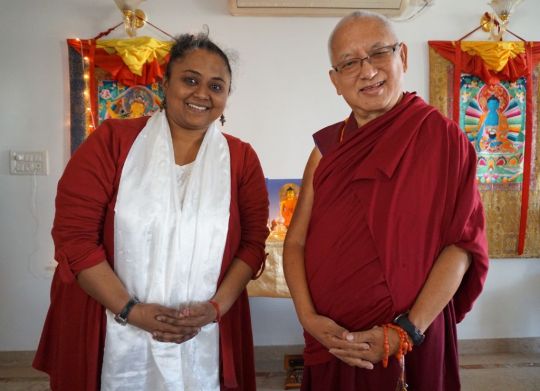
Lama Zopa Rinpoche with FPMT India national coordinator Deepthy Shekhar in Bangalore, India, December 2016. Photo by Ven. Losang Sherab.
In 2014, Indian FPMT students heard Malaysian and Singaporean students chant Lama Zopa Rinpoche’s name mantra in Mundgod and had the wish to learn how to do the same. Ven. Kabir Saxena, now director of Maitreya Buddha Project Kushinagar, suggested that they use an Indian tune instead, since the mantra is in Sanskrit. A Sanskrit chant teacher helped them to compose a tune for the mantra and Indian students were later able to offer this to welcome Rinpoche into the teaching hall when Rinpoche was visiting Bangalore in December 2016.
FPMT India national coordinator Deepthy Shekhar recently shared this beautiful recording of her chanting this mantra for the use of all of Rinpoche’s students.
https://shop.fpmt.org/Lama-Zopa-Rinpoche-Holy-Name-Mantra–MP3-Download-_p_3625.html
Lama Zopa Rinpoche’s name mantra is available to download, and all are welcome to enjoy and utilize the lovely chant offered by Deepthy.
FPMT Education Services makes many other commonly used mantras available for free download. All are welcome to peruse and freely utilize what’s available.
Through comprehensive study programs, practice materials, training seminars, and scholarships, FPMT Education nourishes the development of compassion, wisdom, kindness, and true happiness in individuals of all ages.
- Tagged: deepthy shekhar, mantras, nama mantra
- 0
19
Basic Program Progress, Completions, and Opportunities
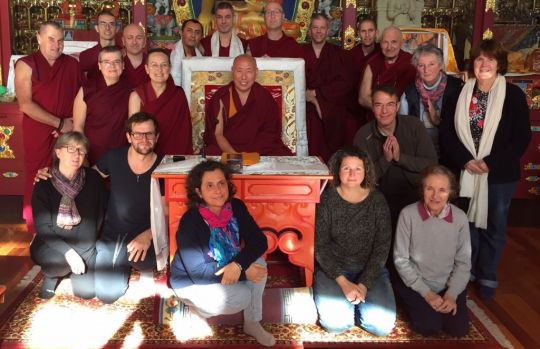
Final session of Nalanda Monastery’s second Basic Program, December 2016. With BP teacher Geshe Jamphel Gyaltsen; BP coordinator Ven. Rigchog (back row, fifth from the right) and their three interpreters, for the English: Katie Fradet (center front); for the Spanish: Montse Lobett Brandt (front row, first on the left); and for the French: Ven. Dorje. Some students were not present for this final session.
FPMT Education Services would like to share some news about Basic Program progress and announce a wonderful new online opportunity. The Basic Program (BP) was designed by Lama Zopa Rinpoche for students who wish to progress beyond foundational level study and practice. It offers an introduction to the philosophical aspects of the Tibetan Buddhist Gelugpa tradition; a substantial practice component balances this scholarly focus, ensuring a well integrated education.
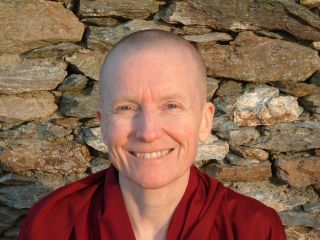
Ven. Sangye Khadro.
Denmark
Tong-nyi Nying-je Ling (Center for Wisdom and Compassion), Copenhagen, will start its first BP at the end of January, taught by resident teacher Ven. Sangye Khadro, Masters Program graduate and In-Depth Buddhism registered teacher. The first semester consists of five monthly weekends and a one-week study-retreat. Offered in English, the video recordings and course materials will also be available online. This is an exclusive opportunity for students worldwide to receive BP teachings from a perfectly qualified Western teacher!
New Zealand
While their second BP is already in progress, Dorje Chang Institute (DCI), Auckland, New Zealand, saw four students complete their first Basic Program with the three-month review final exam: BP interpreter Rinchen Dhondup, the first ever Tibetan interpreter to participate in the review and final exam, DCI spiritual program coordinator Ven. Gyalten Wangmo, who facilitated the review in close cooperation with Education Services, and DCI’s two senior BP discussion group facilitators, Murray Wright and Simon Harrison, both FPMT registered teachers.
Interestingly, as Education Coordinator of (then) Central Office (now known as FPMT International Office) as early as 1992, Murray presented the first proposal outlining Lama Zopa Rinpoche’s wish for a Basic Program, giving the initial curriculum shape and collecting texts, translations and course materials. Little did he know that he’d participate in the program and complete the final exam some twenty-five years later! All four have put a lot of effort and energy into their review and did very well in their exam. We extend our congratulations to BP teacher Geshe Wangchen on the successful completion of his first BP.
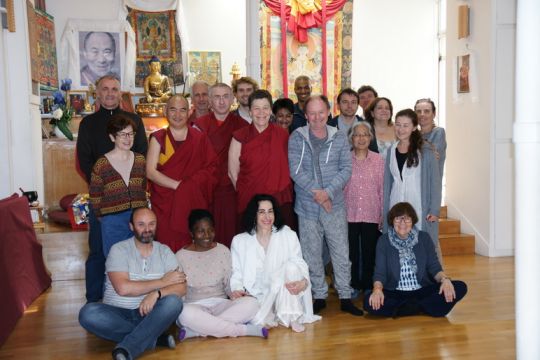
Centre Kalachakra’s last class of their second BP with teacher Geshe Dakpa Tsondu, center director Ven. Elisabeth Drukier (center), BP Coordinator Virginie Breit (second right, back row), and interpreter Lesley (fifth from right, back row). August 2016, Paris, France.
France
In France, Centre Kalachakra in Paris, which offers an excellent and well attended Basic Program that includes meditations, discussions and retreats, had six students complete the review and final exam of their second BP this December.
Nalanda Monastery in Lavaur will complete its second BP with the three-month review, final exam, and the three-month lamrim retreat in 2017. About ten students are expected to graduate from their outstanding five-year residential Basic Program.
Please rejoice that so many students around the world dedicate themselves to intensive Dharma study, and several succeed in completing FPMT’s In-Depth education programs.
Through comprehensive study programs, practice materials, training seminars, and scholarships, FPMT Education nourishes the development of compassion, wisdom, kindness, and true happiness in individuals of all ages.
- Tagged: basic program
- 0
- Home
- News/Media
- Study & Practice
- About FPMT Education Services
- Latest News
- Programs
- New to Buddhism?
- Buddhist Mind Science: Activating Your Potential
- Heart Advice for Death and Dying
- Discovering Buddhism
- Living in the Path
- Exploring Buddhism
- FPMT Basic Program
- FPMT Masters Program
- FPMT In-Depth Meditation Training
- Maitripa College
- Lotsawa Rinchen Zangpo Translator Program
- Universal Education for Compassion & Wisdom
- Online Learning Center
- Prayers & Practice Materials
- Overview of Prayers & Practices
- Full Catalogue of Prayers & Practice Materials
- Explore Popular Topics
- Benefiting Animals
- Chenrezig Resources
- Death & Dying Resources
- Lama Chopa (Guru Puja)
- Lama Zopa Rinpoche: Compendium of Precious Instructions
- Lama Zopa Rinpoche: Life Practice Advice
- Lama Zopa Rinpoche Practice Series
- Lamrim Resources
- Mantras
- Prayer Book Updates
- Purification Practices
- Sutras
- Thought Transformation (Lojong)
- Audio Materials
- Dharma Dates – Tibetan Calendar
- Translation Services
- Publishing Services
- Teachings and Advice
- Find Teachings and Advice
- Lama Zopa Rinpoche Advice Page
- Lama Zopa Rinpoche: Compendium of Precious Instructions
- Lama Zopa Rinpoche Video Teachings
- ༧སྐྱབས་རྗེ་བཟོད་པ་རིན་པོ་ཆེ་མཆོག་ནས་སྩལ་བའི་བཀའ་སློབ་བརྙན་འཕྲིན།
- Podcasts
- Lama Yeshe Wisdom Archive
- Buddhism FAQ
- Dharma for Young People
- Resources on Holy Objects
- Ways to Offer Support
- Centers
- Affiliates Area
- Teachers
- Projects
- Charitable Projects
- Make a Donation
- Applying for Grants
- News about Projects
- Other Projects within FPMT
- Support International Office
- Projects Photo Galleries
- Give Where Most Needed
- FPMT
- Shop
Translate*
*powered by Google TranslateTranslation of pages on fpmt.org is performed by Google Translate, a third party service which FPMT has no control over. The service provides automated computer translations that are only an approximation of the websites' original content. The translations should not be considered exact and only used as a rough guide.My religion is kindness to all







